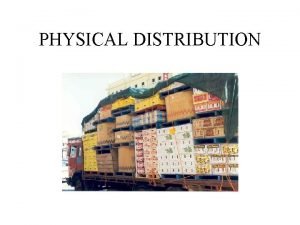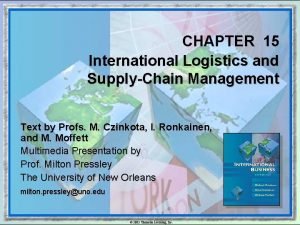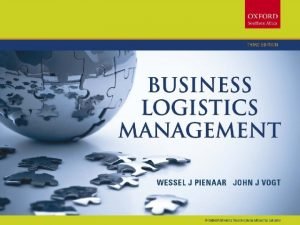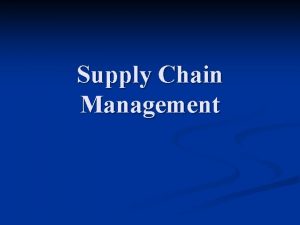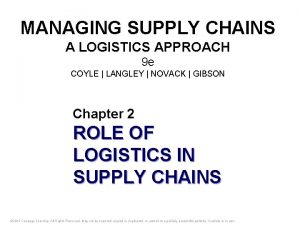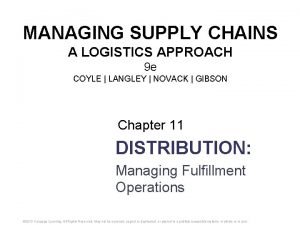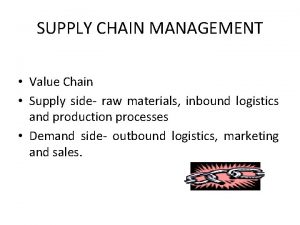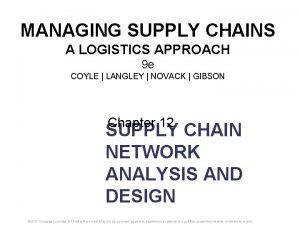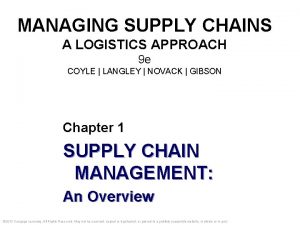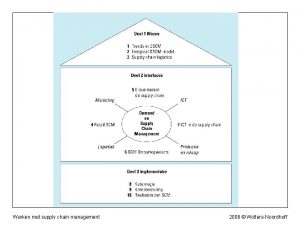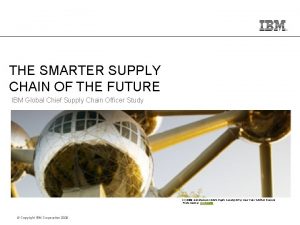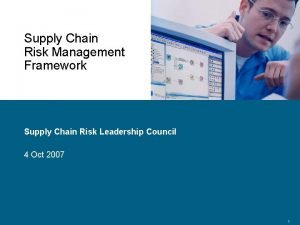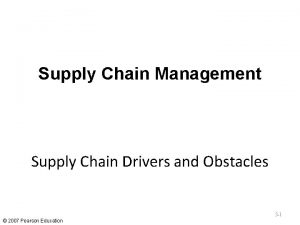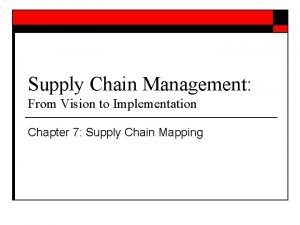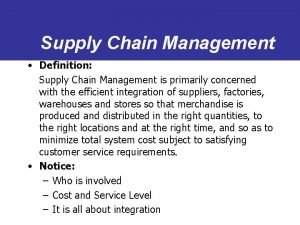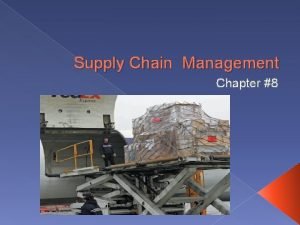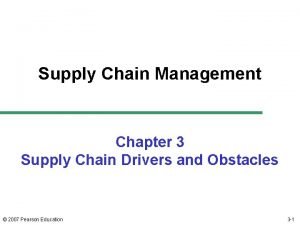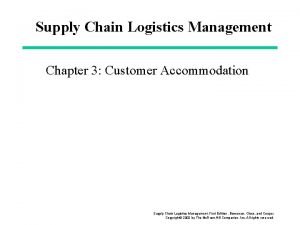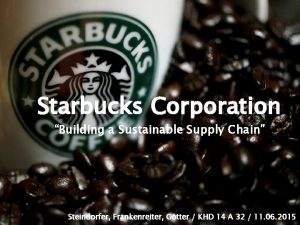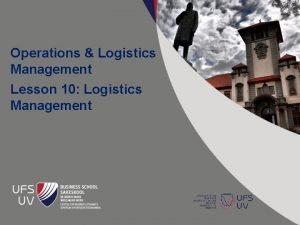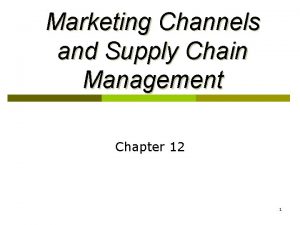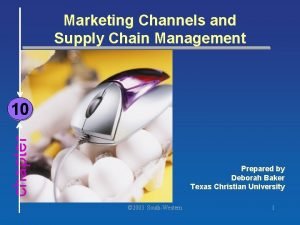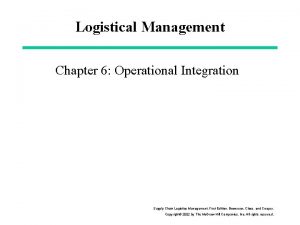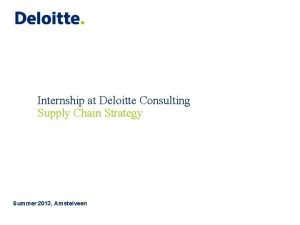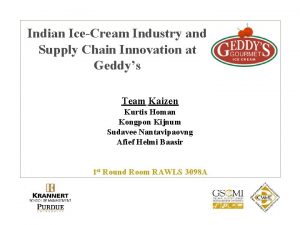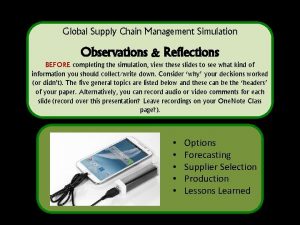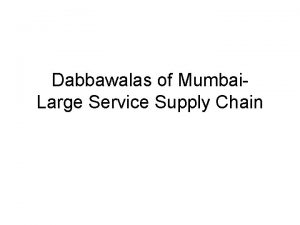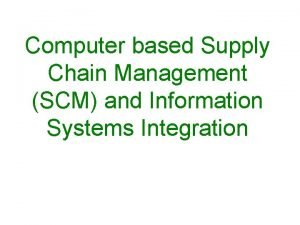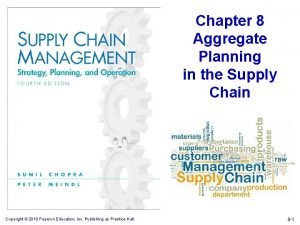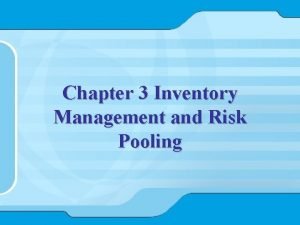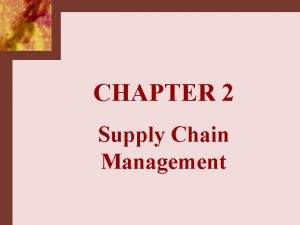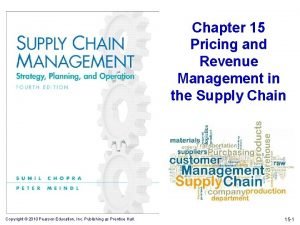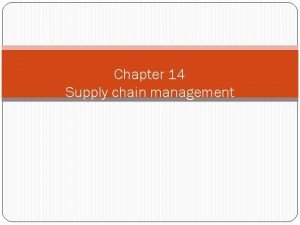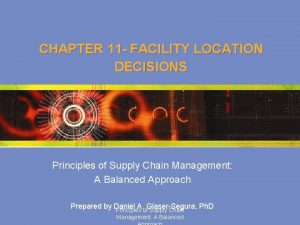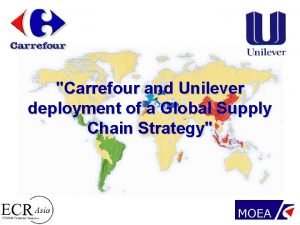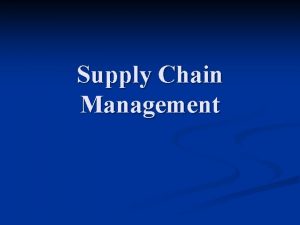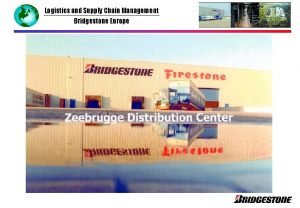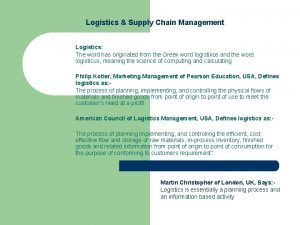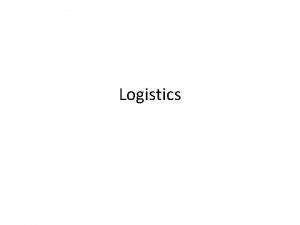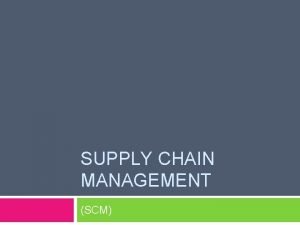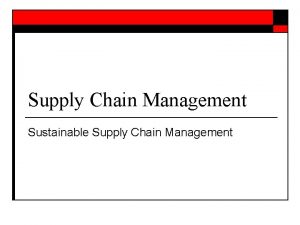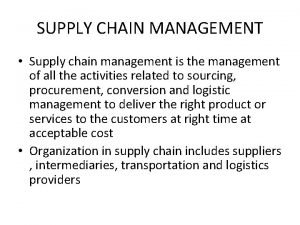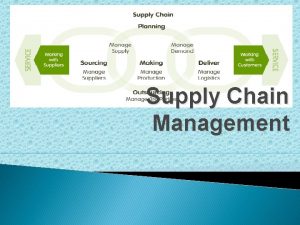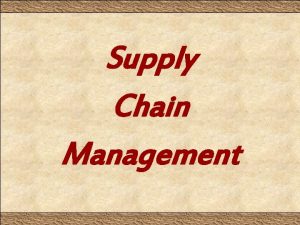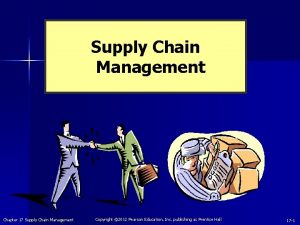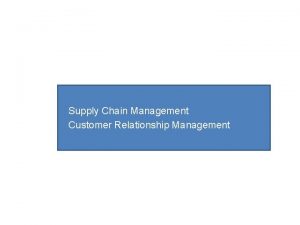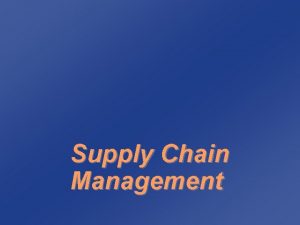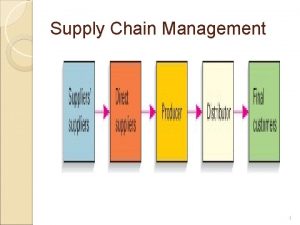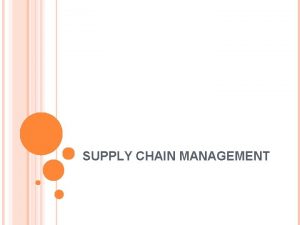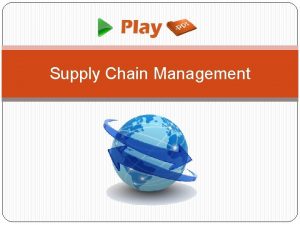Logistics Supply Chain Management Agenda The Supply Chain













































- Slides: 45

Logistics & Supply Chain Management

Agenda…. . • The Supply Chain and Supply Chain Management • Five key SC management concepts: 1. ‘one size never fits all’ 2. Material De-coupling 3. Postponement 4. Reducing the Lead-time Gap 5. Information de-coupling • Logistics and Outsourcing § Reasons for outsourcing logistics § 3 PL and 4 PL service providers Enterprise and its Business Environment © Goodfellow Publishers 2016

In pairs - map the supply chain: players, activities, connections, etc Enterprise and its Business Environment © Goodfellow Publishers 2016

Customs & Excise Cupboard Internet online ordering telephone mobile Car phone Bowl Supermarket Distribution Centre Supermarket Kellogg's Manufacturer Road Tanker Petrol Money Truck Sugar Pipeline Farm Port Truck Mill Port Truck Combine Harvester Ocean Tanker Port Ship Truck Refinery Spoon Port Pipeline Manufacturer of Harvester etc …. . Oil Field etc Radio, Electric light , central heating , gas, TV , water and sewage……………. . etc Enterprise and its Business Environment © Goodfellow Publishers 2016

Supply ‘chains’ are in fact complex ‘networks’ upstream Competing, interconnected supply networks downstream Competing firms 3 rd tier suppliers 2 nd tier suppliers 1 st tier suppliers Focal Firm 1 st tier customer 2 nd tier customer Enterprise and its Business Environment © Goodfellow Interconnected competing supply networks Publishers 2016 End consumers

Networks, not supply chains What else? Enterprise and its Business Environment © Goodfellow Adapted from: http: //www. scotland. gov. uk/Publications/2011/02/22152837/0 Publishers 2016

The Supply Chain encompasses…. . “……. . all activities associated with the flow and transformation of goods from raw materials stage (extraction), through to the user, as well as the associated information flows. Material and information flow both up and down the supply chain. ” Handfield and Nicholas, (1999), p. 2. Enterprise and its Business Environment © Goodfellow Publishers 2016

End customers Primary manufacturers The end-to-end supply chain Focal firm Supply side Purchasing and supply Physical distribution Demand side Supply Chain Management Enterprise and its Business Environment © Goodfellow Publishers 2016 Source: Waters (2002) and Harrison & van Hoek (2002)

Supply Chain Management is. . “……the integration of these activities through improved supply chain relationships, to achieve a sustainable competitive advantage. ” Handfield and Nicholas, (1999), p. 2. Enterprise and its Business Environment © Goodfellow Publishers 2016

Achieving an integrated supply chain Stage One: Baseline Purchasing Manufacturing Distribution • Baseline organisations are characterised by: § § Functional silos Adversarial relationships Sub optimisation Independent planning by function Marketing Customers • Baseline performance leads to: § High total costs § Poor service § High inventory Enterprise and its Business Environment © Goodfellow Publishers 2016

Functional Silos PRODUCTS CUSTOMERS Enterprise and its Business Environment © Goodfellow Publishers 2016

Achieving an integrated supply chain Stage One: Baseline Purchasing Manufacturing Distribution Marketing Customers Stage Two: Process and systems Integration Materials Management Operations Marketing Customers Stage three: External Integration Suppliers • Internal Supply Chain Stage 3 organisations are characterised by: § § § Customers • Stage 3 performance leads to: § Cross-functional and cross-organisational collaboration § ONE shared and agreed PLAN Transparent and easily accessible data (cloud Environment technology) Enterprise and its Business © Goodfellow § Publishers 2016 Optimised operating costs Better availability & responsiveness Reduced inventory

From Functions to Processes: creating an integrated ‘supply chain’ within the company Production Purchasing Distribution Sales & Marketing PRODUCTS CUSTOMERS Enterprise and its Business Environment © Goodfellow Publishers 2016

From a Single company to a Supply Chain perspective Manufacturer Suppliers Retailers Wholesalers PRODUCTS CUSTOMERS “Supply Chains compete not individual companies” Enterprise and its Business Environment © Goodfellow Publishers 2016 Martin Christopher

The goal of SCM is: “…. to manage upstream and downstream relationships with suppliers and customers in order to create enhanced value in the final market place at less cost to the supply chain as a whole. ” (Prof. Martin Christopher) Single company (functional) thinking Supply Chain thinking • Focus on the ultimate consumer • Focus on the customer • Increase profits for all • Increase own profits • Consider total supply chain costs • Consider own costs • Guard ideas, information and resources • Improve internal process efficiency • Share ideas, information and resources • Improve joint process efficiency (Source : A. T. Kearney) Enterprise and its Business Environment © Goodfellow Publishers 2016

Designing a Responsive Supply Chain Five Key concepts: 1. 2. 3. 4. 5. Differentiate - ‘One size never fits all’: Segment /prioritise the product /customer base and design the best supply chain for each; De-couple the supply chain: between Lean (push) and Agile (pull) processes; place strategic inventory at the decoupling point; Postpone: delay adding value wherever possible (form and place postponement); Reduce the Lead-time Gap: work to reduce the gap and become less reliant on finished product forecasts; Use real-time demand data: make real-time demand available upstream at the information de-coupling point, and use it to make supply & production decisions; Enterprise and its Business Environment © Goodfellow Publishers 2016

1. A differentiated supply chain strategy When there are different products with: § different characteristics § e. g. demand volatility/ value / volume / weight / shelf-life / criticality, etc. § different service requirements § e. g. lead-time / delivery frequency / order quantities, etc. Managers need to decide ………. what is the right supply chain for each product-customer segment? “One size never fits all” Enterprise and its Business Environment © Goodfellow Publishers 2016

E. G. Consider demand volume …. 80% % of total demand Agile • Make & distribute to forecast • Low priority in production schedule • Focus on efficiency • Seek economies of scale Lean 20% • Forecast for capacity, execute to demand • Make to order • High priority in production schedule • Hold inventory in generic form % of products Enterprise and its Business Environment © Goodfellow Publishers 2016

Two Supply Chain strategies (NOT mutually exclusive!) Lean “having no surplus flesh or bulk” § Agile “quick in movement : nimble” Waste elimination § Quick response -velocity Robust processes § Flexible processes Minimisation of inventory and WIP § Customised service Cost transparency in the supply chain § End-to-end Visibility Multi skilled workers § Reduced change-over times § Continuous improvement § Postponement of final configuration Synchronised with true demand Value creation Physically Efficient § Market Responsive Enterprise and its Business Environment © Goodfellow Publishers 2016

Consider demand volume and variability Product Variety/ Demand Variability High “Agility” is needed in less predictable environments where the demand for variety is high. AGILE “Lean” works best in high volume, low variety and predictable environments. LEAN Low High Volume Sales (Christopher, 2011, pp 100) Enterprise and its Business Environment © Goodfellow Publishers 2016

Demand supply characteristics determine SC strategy Functional and Innovative Products • “Before devising a supply chain, consider the nature of the demand for your products. ” Functional Innovative Demand Predictable & steady Unpredictable & variable Product Life Cycle > 2 years 3 months to 1 year Contribution Margin 5% to 20% to 60% Product Variety low high Forecast error at time production committed 10% 40% to 100% Average stock-out rate 1% to 2% 10% to 40% Average end-of-season markdown (%full price) 0% 10% to 25% Lead Time 6 months to 1 year 1 day to 2 weeks SC strategy Physically Efficient Market Responsive Enterprise and its Business Environment © Goodfellow Source: Fisher (1997) What is the right Supply Chain for your Product? HBR. Publishers 2016

“One size does not fit all” Functional and Innovative Products Functional products Efficient Innovative products match mismatch Supply Chain Responsive mismatch Supply Chain Source: Fisher (1997) What is the right Supply Chain for your Product? HBR. Enterprise and its Business Environment © Goodfellow Publishers 2016

2. The de-coupling point Lean Agile • Forecast driven • Demand driven • Economic batch quantities • Localised Configuration • Maximise efficiencies • Maximise effectiveness Strategic Inventory Enterprise and its Business Environment © Goodfellow Publishers 2016

2. De-coupling point Driven By Demand Driven By By Forecast 3. Postponement • • • Delay committing products to particular market segments as long as possible, preferably until firm orders have been received; Forecast at a generic level and delay final configuration: FORM Hold stock back in a central location and distribute only when demand is known: LOGISTICAL Enterprise and its Business Environment © Goodfellow Publishers 2016

Traditional Apparel Business Process Design (famous designers) Source Raw Material Produce 100% - Far East Distribute (sea-freight) Retail Stores Discount Sales Industry norm … 6 to 18 months! Zara’s supply chain (lean AND agile strategies; design postponement) Postpone design Source Raw Materials 2 -3 weeks Differentiate Design (new graduates) Produce 80% - Europe 20% - Far East Packaging & Labelling (Spain) Stock Allocation Sales reports Market research Enterprise and its Business Environment © Goodfellow Publishers 2016 Distribution (air & road) Zara Stores

The problem with lead-time SOURCE MAKE DELIVER Supply Chain Lead Time • Longer forecast horizon for planning § Increased uncertainty § More inventory buffer needed • • More inventory needed in the pipeline Greater risk of obsolescence (waste) Deterioration of freshness /quality Less responsive to sudden change in demand Enterprise and its Business Environment © Goodfellow Publishers 2016

4. The Lead-time Gap Make-to-stock PLAN SOURCE MAKE DELIVER Supply Chain Lead Time Customer’s Order Cycle Time Lead-Time Gap Forecast-driven Order Fulfilment FGI Decoupling point /strategic inventory Most organisations fill the gap with inventory BETTER to reduce logistics lead-time and extend customer order cycle by immediate use of information Enterprise and its Business Environment © Goodfellow Publishers 2016

Compress time and reduce the LT Gap Make-to-order ØLess dependent on forecasting ØForecast at a generic level PLAN SOURCE ØReduce MAKE DELIVER Supply Chain Lead Time complexity of planning ØImprove service ØReduce inventory ØMore responsive to the market Customer’s Order Cycle Time Lead-Time Gap Order Fulfilment RM Decoupling point /strategic inventory Enterprise and its Business Environment © Goodfellow Publishers 2016

5. The information de-coupling point Forecast Driven Demand Driven Less uncertainty due to enrichment of undistorted data Push Lo volume / Hi uncertainty Material de-coupling Point 1 Riskpool Pull Material de-coupling Point 2 Hi volume / Lo uncertainty Distribution Suppliers Pull regional stock Production FGI Central DC Information de-coupling Point 1 Regional DC Real-time data Enterprise and its Business Environment © Goodfellow Two key de-coupling points: Material and Information Publishers 2016 Local delivery Retail

Case: Dell Computers • 1983 – Michael Dell, a medical student, buys out-dated IBM PCs and upgrades • them to sell at bargain prices 1987 – Dell Computers build own PCs and sell direct to customers DELL Competitor X Customer -focused Product-focused Assemble-to-order Make-to-forecast JIT-based manufacturing Traditional approach Direct to customers, on-line sales Sell through traditional channels 11 days total inventory Several months inventory Lean & flexible (agile) Slow to respond Low risk of obsolescence High risk of obsolescence Enterprise and its Business Environment © Goodfellow Publishers 2016

‘One size never fits all’ Source: David Simchi-Levi, Annette Clayton and Bruce Raven , Winter 2013, When One Size Does Not Fit All, MIT Sloan Enterprise and its Business Environment © Goodfellow Publishers 2016

Designing a Responsive Supply Chain Five Key concepts: 1. 2. 3. 4. 5. Differentiate - ‘One size never fits all’: Segment /prioritise the product /customer base and design the best supply chain for each; De-couple the supply chain: between Lean (push) and Agile (pull) processes; place strategic inventory at the decoupling point; Postpone: delay adding value wherever possible (form and place postponement); Reduce the Lead-time Gap: work to reduce the gap and become less reliant on finished product forecasts; Use real-time demand data: make real-time demand available upstream at the information de-coupling point, and use it to make supply & production decisions; Enterprise and its Business Environment © Goodfellow Publishers 2016

What is Logistics? ‘The process of strategically managing the movement and storage of materials, parts and finished inventory from suppliers, through the firm and on to customers. ’ Professor Martin Christopher ‘Logistics is the function responsible for moving materials through their supply chain. ’ Donald Waters, Global Logistics, 2010. Enterprise and its Business Environment © Goodfellow Publishers 2016

The goal of Logistics To achieve a target level of customer service at lowest possible cost Source: Waters (2002) Warehousing; Materials handling; Inventory; Packaging and Recycling Freight Transport: inbound and outbound logistics; Information Enterprise and its Business Environment © Goodfellow Publishers 2016

Reasons why companies often Outsource Logistics § Improve services & Increase flexibility § Reduce costs: Econmies of scale and scope § Avoid capital investment & convert logistics from capital to expenditure § Logistics is a non-core activity, concentrate on core competencies § Reduce labour costs § Logistics service providers offer greater logistics expertise Refer to Langley and Cap. Gemini Annual Third-Party Logistics Study http: //www. 3 plstudy. com/ Enterprise and its Business Environment © Goodfellow Publishers 2016

Who are Logistics Service Providers? Enterprise and its Business Environment © Goodfellow Publishers 2016

Problems with Outsourcing § § § Loss of control over distribution network Loss of management expertise in logistics Loss of direct contact with customer! Increasing risk of service failure Tendency to underestimate core competences Dependency on contractors Source: Tsai et al. (2012) „The dark side of logistics outsourcing“ Enterprise and its Business Environment © Goodfellow Publishers 2016

Classifying logistics companies • logistics service providers (LSPs) § § Hauliers or trucking companies Freight forwarders Couriers Integrators (e. g. Fed. Ex, UPS and DHL) • Third Party Logistics Providers (3 PLs) Typical Services included: • Transportation – air, road, rail, ship • Warehousing • Pick and Pack, Labelling • Light manufacturing /assembly • Vendor managed inventory (VMI) • Inventory management • Spare Parts distribution • Customs clearance • Managing reverse logistics – returns • Recycling of packaging Considerable overlap between the terminology • All companies that provide logistics services are LSPs • LSPs that provide multiple logistics services, often integrated, are third party logistics providers (3 PLs) (adapted from Mangan et al. , 2011) Enterprise and its Business Environment © Goodfellow Publishers 2016

Working with Logistics Service Providers Two case studies on how service provider improves competitiveness of adidas and nortel networks http: //www. kn-portal. com/fileadmin/_public/documents/material/ KNUCLCS_Nortel_Lead_Logistics_061504. pdf https: //www. ups-scs. com/solutions/case_studies/cs_adidas. pdf Enterprise and its Business Environment © Goodfellow Publishers 2016

Working with Logistics Service Providers: an example of Strategic Collaboration • Penske - Ford Network Integrator Concept • Winners of the European Logistics Excellence Award 2012 Enterprise and its Business Environment © Goodfellow Publishers 2016

Fourth party logistics (4 PL®) • Offering total outsourced supply chain solutions • Originally trademarked by Accenture in 1996 A supply chain integrator that manages the resources, capabilities and technology of its own organisation, with those complementary service providers, to deliver a comprehensive supply chain solution • 3 PL and 4 PL® are often indistinguishable • Li and Fung Ltd. – often considered equivalent to a 4 PL. Hong Kong based traders who ‘orchestrate’ global supply chains. • Li & Fung is a global sourcing firm, that supplies high-volume, timesensitive consumer goods from an extensive global network of suppliers and distributors. Growth at Li & Fung We connect the supply chain to bring our customers the goods they rely on every day Enterprise and its Business Environment © Goodfellow Publishers 2016

Apple: outsourcing a global value chain o High value-added activities outsourced to developed countries, e. g. Germany. These activities are controlled by firms like ARM Holdings (chip design) and Balda AG (touchscreens). o Marketing support activities are located in the USA. o Routine ‘contract’ manufacturing and assembly outsourced to Taiwaneses firms like Hon Hai Precision Industry (Foxconn factory in Shenzhen). o Relatively complex items, such as chips, are manufactured to design specifications by Samsung in Korea and NXP Semiconductor in the Netherlands. o For each i. Phone imported in the United States, its entire factory gate price ($194. 04 in this case) is attributed as a trade deficit with China. In reality, only about 3% of the wholesale added value takes place in China Source: adapted from OECD (2011) "Global Value Chains: Preliminary Evidence and Policy Issues", Organization for Economic Co-operation and Development, DSTI/IND(2011)3, Enterprise and its Business Environment © Goodfellow Paris, 2011. http: //people. hofstra. edu/geotrans/eng/ch 5 en/conc 5 en/iphone_3 g_components. html Publishers 2016

Outsourcing can go wrong! Lessons to be learned from BA‘s outsourcing § § BA and Gate Gourmet in August 2005 Outsourcing in-flight catering ? Operational costs increased Loss of customer loyalty http: //www. linklaters. com/Insights/Publication 1403 Newsletter/Pub lication. Issue 20051001/Pages/Publication. Issue. Item 656. aspx „The advantages of outsourcing are widely appreciated and, as long as the risks are also carefully considered, it remains a highly effective business strategy. “ „If the airline had still been in charge, it would have known the strain and risk to which it was submitting its supply chain“ – anonymous observer Enterprise and its Business Environment © Goodfellow Publishers 2016

Final thought: The Supply Chain is the Business “The complexity of the business is not in the manufacturing, its in the logistics. This is more of a logistics machine than a manufacturing plant. ” Bob Beaty, IBM “Putting cars together is a relatively straightforward exercise. Getting all the parts together at the right place and time with minimum inventory is the real challenge” Production Director, Nissan “Our focus is on markets and products, but without an effective supply chain we cannot even begin to compete” CEO, Unilever. “The supply chain is the biggest leverage point we have” (Dell) “The supply chain is the business model” (Zara) “Supply Chains compete, not individual organisations” Prof. Martin Christopher Enterprise and its Business Environment © Goodfellow Publishers 2016

Further Reading: Christopher, M. (2011), Logistics and Supply Chain Management (4 th Edition) Pitman Rushton, A. , Croucher, P. & Baker, P. (2006), The Handbook of Logistics and Distribution Management (3 rd Edition), Kogan Page, London Grant, Lambert, Stock & Ellram (2006) Fundamentals of Logistics Management, European Edition, Mc. Graw-Hill, London. Key Journals: International Journal of Physical Distribution and Logistics Management International Journal of Logistics Management Supply Chain Management: An International Journal of Logistics Journal of Business Logistics International Journal of Logistics: Research and Applications Enterprise and its Business Environment © Goodfellow Publishers 2016
 Crm in logistics and supply chain management
Crm in logistics and supply chain management Ford logistics and supply chain management
Ford logistics and supply chain management Component of physical distribution
Component of physical distribution Global logistics and supply chain strategy
Global logistics and supply chain strategy Difference between logistics and supply chain
Difference between logistics and supply chain International logistics and supply chain outsourcing
International logistics and supply chain outsourcing Vision of supply chain management
Vision of supply chain management Supply chain management and total quality management ppt
Supply chain management and total quality management ppt Supply chain sequence
Supply chain sequence Agenda sistemica y agenda institucional
Agenda sistemica y agenda institucional Matching supply and demand in supply chain
Matching supply and demand in supply chain Food chain food chain food chain
Food chain food chain food chain Managing supply chains a logistics approach
Managing supply chains a logistics approach Managing supply chains: a logistics approach
Managing supply chains: a logistics approach Vender vs supplier
Vender vs supplier Managing supply chains a logistics approach
Managing supply chains a logistics approach Managing supply chains a logistics approach
Managing supply chains a logistics approach Werken met supply chain management
Werken met supply chain management Ibm supply chain strategy
Ibm supply chain strategy Supply chain risk management framework
Supply chain risk management framework Supply chain risk management framework
Supply chain risk management framework Cisco supply chain risk management
Cisco supply chain risk management Drivers of supply chain management
Drivers of supply chain management Pipeline in supply chain
Pipeline in supply chain Supply chain management definition
Supply chain management definition Supply chain upstream and downstream
Supply chain upstream and downstream Chapter 3 supply chain drivers and metrics
Chapter 3 supply chain drivers and metrics Customer accommodation example
Customer accommodation example Starbucks sustainable supply chain
Starbucks sustainable supply chain Introduction to operations and supply chain management
Introduction to operations and supply chain management The network made up of the company suppliers distributors
The network made up of the company suppliers distributors Marketing channels and supply chain management
Marketing channels and supply chain management Chapter 6 supply chain management
Chapter 6 supply chain management Principes fondamentaux supply chain management pdf
Principes fondamentaux supply chain management pdf Deloitte supply chain internship
Deloitte supply chain internship Supply chain management in ice cream industry
Supply chain management in ice cream industry Global supply chain management simulation
Global supply chain management simulation Dabbawala supply chain
Dabbawala supply chain Computer based supply chain management
Computer based supply chain management Aggregate planning in supply chain management
Aggregate planning in supply chain management Inventory management and risk pooling
Inventory management and risk pooling Total cost concept in supply chain management
Total cost concept in supply chain management Role of pricing and revenue management in a supply chain
Role of pricing and revenue management in a supply chain Order processing in supply chain management
Order processing in supply chain management Location
Location Carrefour supply chain management
Carrefour supply chain management


